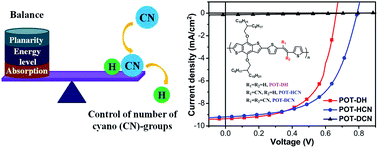Effects of cyano (CN)-groups on the planarity, film morphology and photovoltaic performance of benzodithiophene-based polymers†
Abstract
A class of polymers (POT-DH, POT-HCN and POT-DCN) were synthesized and they contain the same donor (BDT) and acceptor units but different numbers of cyano (CN)-groups, i.e. 0, 1 and 2. We investigated for the first time the effects of different CN-group numbers on the optoelectronic, molecule packing, film morphology and photovoltaic properties of three conjugated polymers. With increased CN-group number, broader absorption, smaller optical bandgap and lower HOMO level can be obtained. The planarity of polymers also decreases with increasing CN-groups, leading to different inter-molecular packing and morphology. The incorporation of two CN-groups results in poor morphology, inefficient charge transfer and very low device performance. Due to the optimized POT-HCN polymer possessing the most balanced properties, the best PCE of 4.21% was demonstrated by POT-HCN with one CN-group. Thus we believe that, by controlling the number of introduced CN-groups, we can generally fine-tune the planarity and LUMO/HOMO levels of this class of polymers to achieve desired optoelectronic properties and morphology for high photovoltaic performance. This also provides a feasible way for optimizing other photovoltaic semiconducting polymers by adjusting the number of electron-withdrawing units.


 Please wait while we load your content...
Please wait while we load your content...